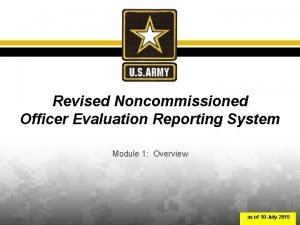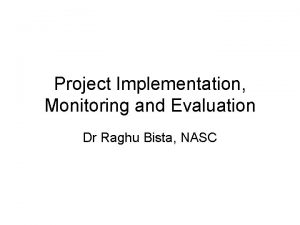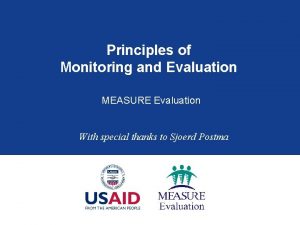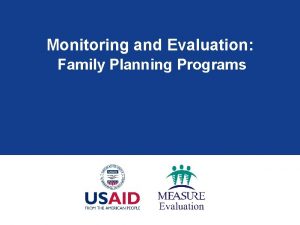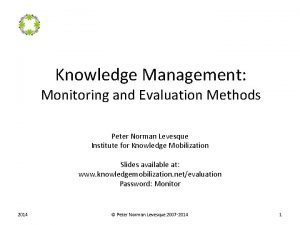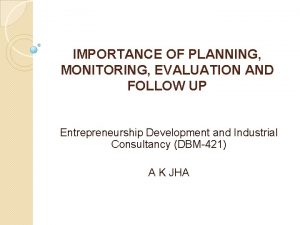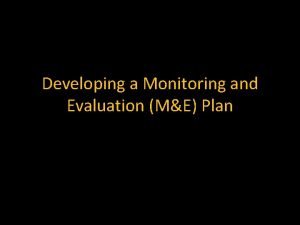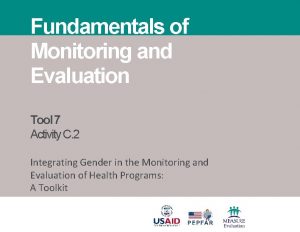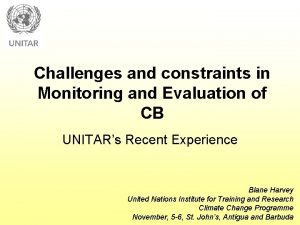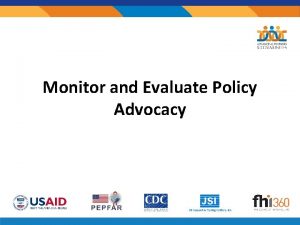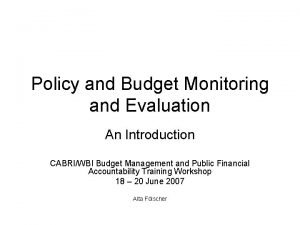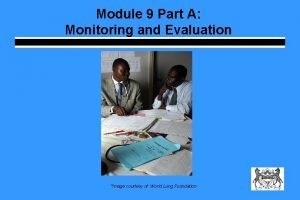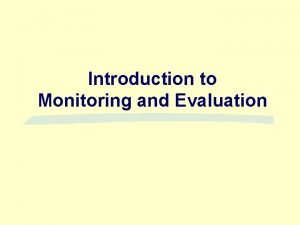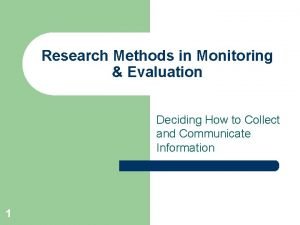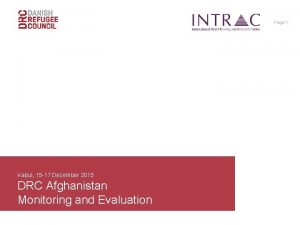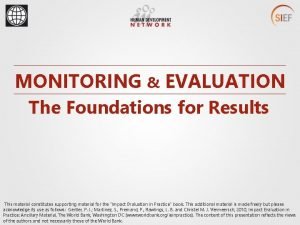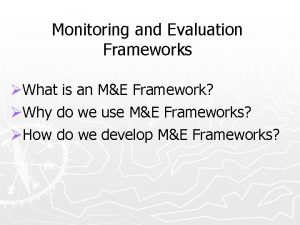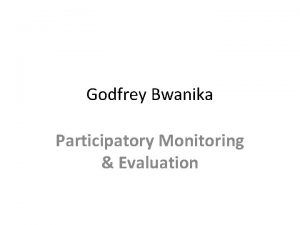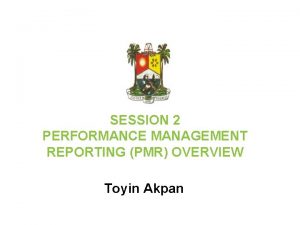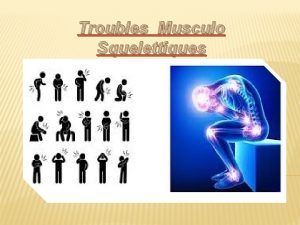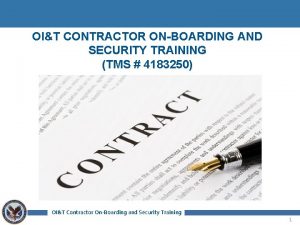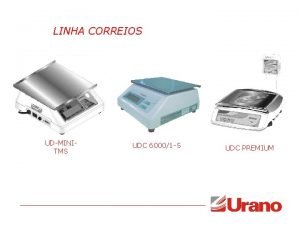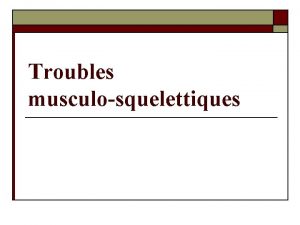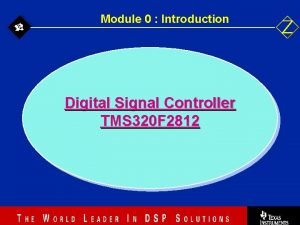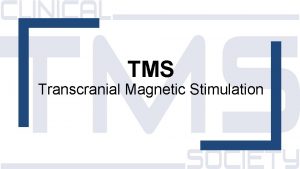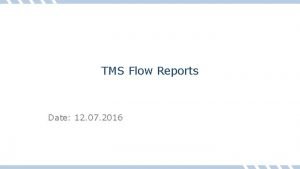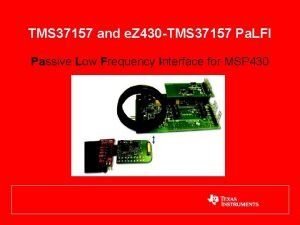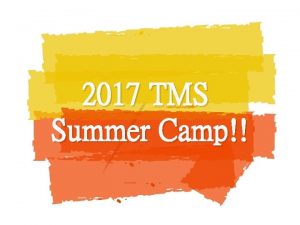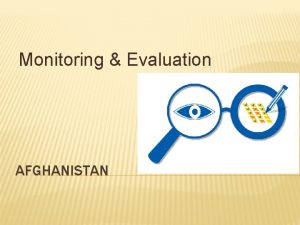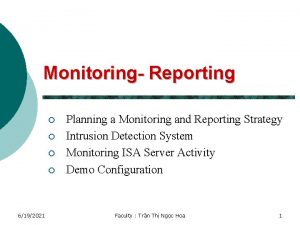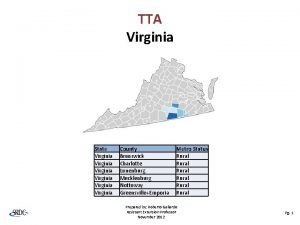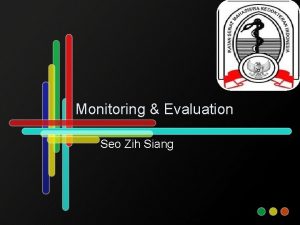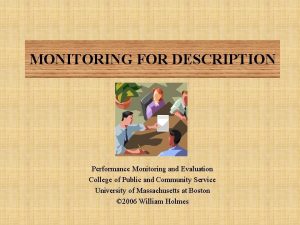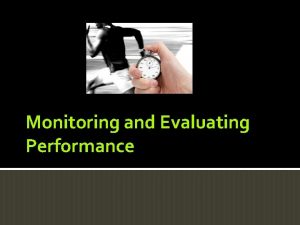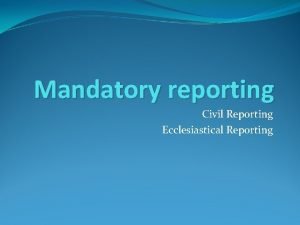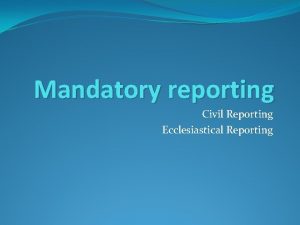TMS Performance Monitoring Evaluation Reporting University of Virginia











































- Slides: 43

TMS Performance Monitoring, Evaluation, & Reporting University of Virginia & SAIC

Presentation Outline Subject overview Ø Performance measures Ø Performance measurement program Ø Data Ø Performance monitoring, evaluation, and reporting Ø Handbook information Ø

Transportation Management Systems The deployed form of ITS, along with human resource contribution, toward transportation management Ø Includes computer hardware, software, communications, surveillance technology Ø TMC is a physical facility that houses central equipment, software, and personnel that operate TMS Ø

Performance Monitoring, Evaluation, & Reporting Monitoring is ongoing internal process where system conditions are examined through collected data Ø Evaluation is process where collected data is analyzed and compared to set benchmarks. Ø Reporting provides the results of the evaluation for the stakeholders. Ø

Performance Measures Provide quantifiable indicators of program effectiveness and efficiency Ø Help to determine progress toward specific program goals and objectives Ø Help to determine priority projects, goal/objective refinements, and fund allocation Ø

Performance Measure Types Ø Input n Ø Output n Ø Supply of resources Delivery of transportation programs, projects, and services Outcome n Degree to which transportation system meets policy goals and objectives

Performance Measure Types

Criteria for Defining Performance Measures Purpose Ø Validity Ø Precision Ø Accuracy Ø Cost-effectiveness Ø

TMS/TMC Functions

Freeway TMS Performance Measures Ø Incident Management – General Measures Metric Type Supplementary Notes Calculation Number of incidents, by severity (e. g. , fatal, injury), by type (e. g. , crash, stalled vehicle) external n/a Person hours working for TMS/TMC incident management system input Both infield and TMC No. People x working hours person Number of responded crashes versus total number of crashes output Responded crashes are crashes responded by state safety patrol or freeway incident response team No. of responded crashes over total no. of crashes reported Response time to incidents output n/a

Performance Measurement Program Ø Performance measurement n Ø Use of quantifiable indicators to determine progress made toward agency goals and objectives Program is organized set of measures that combine to quantify and evaluate TMS goals and objectives

Performance Measurement Program Benefits Accountability Ø Efficiency Ø Effectiveness Ø Communications Ø Clarity Ø Improvement Ø

Establishing Performance Measurement Program Ø Key steps n n n n Identify the vision, goals, and objectives of the agency Identify intended uses and audiences Develop TMS performance measures and relate to respective programs. Identify performance benchmarks. Collect complete, accurate, and consistent data Analyze and evaluate data Report data to stakeholders Identify areas for improvement/change and report to stakeholders

Denver Performance Measurement Program Ø Ø Regional Transportation District established in 1969 3 -tiered performance measurement program n n n Ø Ø Service Standards Quarterly Progress Report Annual Report Measures reviewed using established standards Collect economic and customer satisfaction measures

Performance Measurement & Data Ø Data is important aspect of performance measurement program Quantity n Quality n Coverage n Ø Without “good” data, performance measurement program cannot be effective

Data Success of performance measurement plan relies heavily on quality of data Ø Data requirements must be defined Ø Requirements specify the types of data needed for an application, domain, or component Ø

Data Requirement Issues Multiple concurrent incidents Ø Local economy Ø Data should be Ø Relevant n Timely n Cost-effective n Ø Sensor coverage

Data Categories Ø Facility use and performance n Ø Staff activities and resource use n Ø Determine if TMS is operating at full effectiveness Measure the efficient use of agency resources Events and incidents that affect normal traffic conditions

Data Collection Ø Data obtained from 3 sources Data archives n Modeling/estimation n Manual/automatic data collection n

Data Archiving Helps to make long-term evaluation possible with regard to these categories. Ø Reasons to archive: Ø Greater and more accurate data n Cost-effective n Cheaper than manual collection n Adheres to current business practices n

Data Collection/Archiving Issues Availability Ø Completeness Ø Coverage Ø Quality Ø Standards Ø Reliability Ø Variability Ø

Data Collection/Archiving Issues (Cont’d) Aggregation level Ø Experimental design Ø Storage Ø Metadata Ø Institutional/data sharing Ø

Data Archiving Best Practice Ø Pe. MS Freeway performance management system created by Caltrans and UC-Berkeley n Gathers raw, real-time freeway data from participating districts n Established process for processing data n http: //transacct. eecs. berkeley. edu n

Performance Monitoring Using performance measurement to visualize system status Ø Immediate decisions based this information Ø Long-term monitoring can assist with decision-making Ø Maintenance n Future deployment n

Performance Monitoring Levels System operators typically focus on dayto-day operations of one corridor or roadway Ø Supervisors generally focus on several corridors or entire region Ø Managers generally focus on entire TMS at high level with daily/weekly reports Ø

Monitoring Example http: //www. dot. ca. gov/dist 11/d 11 tmc/sdmap/mapmain. html

Performance Evaluation Analysis of data about the TMS Ø Results compared to benchmark measures Ø Used to determine effectiveness of strategies, policies, systems, etc. Ø Helps identify areas to improve and justify the need for additional resources Ø

Performance Evaluation Ø Allows for the following: Determination of actual improvement in performance n Identification of problems that result in inefficiencies n Analysis and prioritization of alternative solutions n Estimation of the benefits and costs of TMS n

Evaluation Techniques Ø Prior to selecting a tool to evaluate the TMS, agencies need to consider the following: Analysis context (planning, design, ops, etc. ) n Geographic scope (corridor, region, etc. ) n Capability of modeling facilities (freeway, HOV lanes, etc. ) n Ability to analyze various modes n

Evaluation Techniques (Cont’d) Ø Also must consider Ability to analyze different management strategies (ramp metering, signal coordination, etc. ) n Ability to estimate traveler response to management strategies (route diversion, mode shift, etc. ) n Ability to output direct performance measures (safety, efficiency, etc. ) n Tool/cost effectiveness n

Before-and-After Evaluation Most common method to evaluate TMS effectiveness Ø Studies effects of particular management strategy by studying performance measurement results from before and after the implementation Ø

Before-and-After Evaluation Issues Difficulty in distinguishing effects of one improvement when multiple ones were made at once Ø Time needed for drivers to adjust to change Ø Time-related factors Ø Regression to the mean Ø

Best Practice Before-and-after study of Phase I of I-10/I 17 FMS in Phoenix area Ø Studied several MOEs for 57 km of freeway fitted with ramp meters, VMS, loop detectors, CCTV cameras Ø 2 -6% travel time improvement along seven-mile stretch with ramp meters Ø

Performance Reporting Allows for communication with stakeholders about system performance Ø Helps in decision-making process Ø Allows for tracking of TMS progress Ø Creates sense of accountability Ø

Reporting Trends Using the media Ø Daily/weekly intranet postings Ø Quarterly/monthly public reports on the Internet Ø Formal biannual/annual reports for government/business officials Ø “Notebooks” keep key decision-makers up to date on agency performance/goals Ø

Reporting Best Practice WSDOT’s “Gray Notebook” Ø Explains agency’s planning process and rationale behind decision-making Ø Assesses statewide conditions Ø Tracks assortment of reliability and effectiveness measures for routine review Ø Has become important source for state legislators and other agency stakeholders Ø

Handbook Overview Handbook serves as a technical reference on performance monitoring, evaluation, and reporting Ø Provides ways for planning, implementing, and sustaining a performance measurement program Ø Discusses issues related to data collection and archiving Ø

Handbook Overview (Cont’d) Ø Intended audience include representatives of n n Ø State DOTs MPOs Transit agencies Enforcement agencies Intended audience is also anyone with role in TMS/TMC performance monitoring, evaluation, and reporting


Handbook At-A-Glance Ø Ø Ø Chapter 1 – Introduction. Defines the background, purpose, and scope of the handbook and the intended audience. Chapter 2 – Overview of TMS Performance Monitoring, Evaluation, and Reporting. Provides a high level overview of TMS performance monitoring, evaluation, and reporting and how they relate to TMSs. Chapter 3 – Performance Measurement Program. Discusses the purpose and importance of, and need for a TMS performance measurement program.

Handbook At-A-Glance Ø Ø Chapter 4 – Agency Goals and Performance Measures. Presents typical performance measurement goals of TMS-related agencies. Also provides high-level performance measures by TMS functions and calculation methods of such performance measures. Chapter 5 – Data Requirements, Collection and Archiving. Provides performance measure data requirements and best practices for data collection, evaluation, and reporting.

Handbook At-A-Glance (cont’d) Ø Chapter 6 – Performance Monitoring, Evaluation and Reporting. Explains various monitoring and evaluation methodologies and processes related to TMS performance. Discusses recommended reporting techniques, formats, and frequencies for reporting TMS performance. Ø Chapter 7 – Self- Assessment. A checklist of questions drawn from case studies. Can be used by TMCs to assess the status and performance of the TMS. Also includes some best practice examples from selected agencies. Ø Appendix A – Survey Questionnaire and Results Ø Appendix B – Contact List of Traffic Management Centers

Other Subject Information Fact sheet Ø FAQ Ø Tri-fold brochure Ø Primer Ø Available at http: //tmcpfs. ops. fhwa. dot. gov/Projects. htm Ø FHWA-HOP-07 -126
 Virginia mandatory reporting law domestic violence
Virginia mandatory reporting law domestic violence Seo northern virginia
Seo northern virginia Army ees ncoer
Army ees ncoer Pme project management
Pme project management Comparison between monitoring and evaluation
Comparison between monitoring and evaluation Principles of monitoring and evaluation
Principles of monitoring and evaluation M&e dashboard
M&e dashboard Monitoring and evaluation of family planning programs
Monitoring and evaluation of family planning programs Knowledge management monitoring and evaluation
Knowledge management monitoring and evaluation Importance of planning, monitoring and evaluation
Importance of planning, monitoring and evaluation Monitoring plan sample
Monitoring plan sample Principles of monitoring and evaluation
Principles of monitoring and evaluation Picme2.0
Picme2.0 Basics of monitoring and evaluation
Basics of monitoring and evaluation Challenges in monitoring and evaluation
Challenges in monitoring and evaluation Centre for evaluation and monitoring
Centre for evaluation and monitoring Types of project monitoring
Types of project monitoring Monitoring and evaluation in advocacy
Monitoring and evaluation in advocacy Budget monitoring and evaluation
Budget monitoring and evaluation Monitoring and evaluation image
Monitoring and evaluation image Introduction to monitoring and evaluation
Introduction to monitoring and evaluation Monitoring and evaluation tool sample deped
Monitoring and evaluation tool sample deped Research methods in monitoring and evaluation
Research methods in monitoring and evaluation Example of monitoring and evaluation in project proposal
Example of monitoring and evaluation in project proposal Difference between monitoring and evaluation
Difference between monitoring and evaluation What are the objectives of evaluation
What are the objectives of evaluation Monitoring and evaluation framework
Monitoring and evaluation framework School monitoring, evaluation and plan adjustment sample
School monitoring, evaluation and plan adjustment sample Teacher subject improvement plan template
Teacher subject improvement plan template Centre for evaluation and monitoring
Centre for evaluation and monitoring What are the steps in performance management process
What are the steps in performance management process Tms définition
Tms définition Dsp tms
Dsp tms Brb423
Brb423 Brb sempure 60
Brb sempure 60 Note de cadrage tms pro exemple
Note de cadrage tms pro exemple Tms onboarding
Tms onboarding Logo tms pro
Logo tms pro Tms correios
Tms correios Tms définition
Tms définition Tms automation
Tms automation Tms 320
Tms 320 Tms carrefour puissance
Tms carrefour puissance Tms coude
Tms coude


